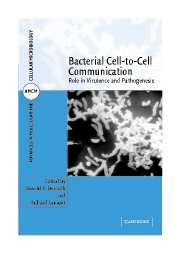Book contents
- Frontmatter
- Contents
- List of Contributors
- Preface
- 1 Quorum sensing and regulation of Pseudomonas aeruginosa infections
- 2 The Pseudomonas aeruginosa quinolone signal
- 3 Quorum-sensing-mediated regulation of plant–bacteria interactions and Agrobacterium tumefaciens virulence
- 4 Jamming bacterial communications: new strategies to combat bacterial infections and the development of biofilms
- 5 Quorum-sensing-mediated regulation of biofilm growth and virulence of Vibrio cholerae
- 6 LuxS in cellular metabolism and cell-to-cell signaling
- 7 LuxS-dependent regulation of Escherichia coli virulence
- 8 Quorum sensing and cell-to-cell communication in the dental biofilm
- 9 Quorum-sensing-dependent regulation of staphylococcal virulence and biofilm development
- 10 Cell-density-dependent regulation of streptococcal competence
- 11 Signaling by a cell-surface-associated signal during fruiting-body morphogenesis in Myxococcus xanthus
- Index
- Plate Section
- References
1 - Quorum sensing and regulation of Pseudomonas aeruginosa infections
Published online by Cambridge University Press: 08 August 2009
- Frontmatter
- Contents
- List of Contributors
- Preface
- 1 Quorum sensing and regulation of Pseudomonas aeruginosa infections
- 2 The Pseudomonas aeruginosa quinolone signal
- 3 Quorum-sensing-mediated regulation of plant–bacteria interactions and Agrobacterium tumefaciens virulence
- 4 Jamming bacterial communications: new strategies to combat bacterial infections and the development of biofilms
- 5 Quorum-sensing-mediated regulation of biofilm growth and virulence of Vibrio cholerae
- 6 LuxS in cellular metabolism and cell-to-cell signaling
- 7 LuxS-dependent regulation of Escherichia coli virulence
- 8 Quorum sensing and cell-to-cell communication in the dental biofilm
- 9 Quorum-sensing-dependent regulation of staphylococcal virulence and biofilm development
- 10 Cell-density-dependent regulation of streptococcal competence
- 11 Signaling by a cell-surface-associated signal during fruiting-body morphogenesis in Myxococcus xanthus
- Index
- Plate Section
- References
Summary
INTRODUCTION
Pseudomonas aeruginosa is a ubiquitous Gram-negative microorganism that thrives in many environments, from soil and water to animals and people. It is an opportunistic pathogen that can cause respiratory infections, urinary tract infections, gastrointestinal infections, keratitis, otitis media, and bacteremia. P. aeruginosa is the fourth most common nosocomial pathogen, accounting for approximately 10% of hospital-acquired infections (www.cdc.gov). Immunocompromised patients, such as those undergoing cancer treatment or those infected with AIDS, burn patients, or cystic fibrosis (CF) patients, are susceptible to P. aeruginosa infections. These infections are difficult to treat by using conventional antibiotic therapies, and hence result in significant morbidity and mortality in such patients. The recalcitrant nature of P. aeruginosa infections is thought to be due to the organism's intrinsic antibiotic resistance mechanisms and its ability to form communities of bacteria encased in an exopolysaccharide matrix; such communities are known as biofilms.
P. aeruginosa possesses an impressive arsenal of virulence factors to initiate infection and persist in the host. These include secreted factors, such as elastase, proteases, phospholipase C, hydrogen cyanide, exotoxin A, and exoenzyme S, as well as cell-associated factors, such as lipopolysaccharide (LPS), flagella, and pili. The expression of these factors is tightly regulated. Many factors are expressed in a cell-density-dependent manner known as quorum sensing (QS). Quorum sensing, or cell-to-cell communication, is a means by which bacteria can monitor cell density and coordinate population behavior. The behavior was first identified in Vibrio fischeri as a mechanism to induce bioluminescence (20).
- Type
- Chapter
- Information
- Bacterial Cell-to-Cell CommunicationRole in Virulence and Pathogenesis, pp. 1 - 22Publisher: Cambridge University PressPrint publication year: 2006
References
- 1
- Cited by

